The Impact of Racism and Race on Indigenous Australian Health
VerifiedAdded on 2022/11/25
|10
|3350
|346
Essay
AI Summary
This essay delves into the critical issue of racism and its detrimental impact on the health and well-being of Indigenous Australians in Australia. It examines the historical and contemporary aspects of racism, including both community attitudes and governmental negligence. The essay explores how racism manifests through unfair disparities in power, resources, and opportunities, leading to discrimination in various life settings such as education and public services. It highlights the link between racism and poor health outcomes, including anxiety, depression, and physical illnesses. The essay discusses pathways from racism to ill health, such as reduced access to resources, increased exposure to risk factors, and direct impacts of racially motivated harm. It also addresses the negative emotional and behavioral responses to racism, such as substance abuse, and provides examples of how racism acts as a barrier to health improvement, impacting cardiovascular health and maternal health outcomes. The essay analyzes the role of systemic racism within healthcare, the effects of chronic exposure to racism, and the need for anti-racism strategies, laws, and policies to mitigate the impact of racism and promote health equity for Indigenous Australians.

Running Head: HEALTHCARE
0
Impact of racism and race on Indigenous Australians health in Australia
5/16/2019
0
Impact of racism and race on Indigenous Australians health in Australia
5/16/2019
Paraphrase This Document
Need a fresh take? Get an instant paraphrase of this document with our AI Paraphraser
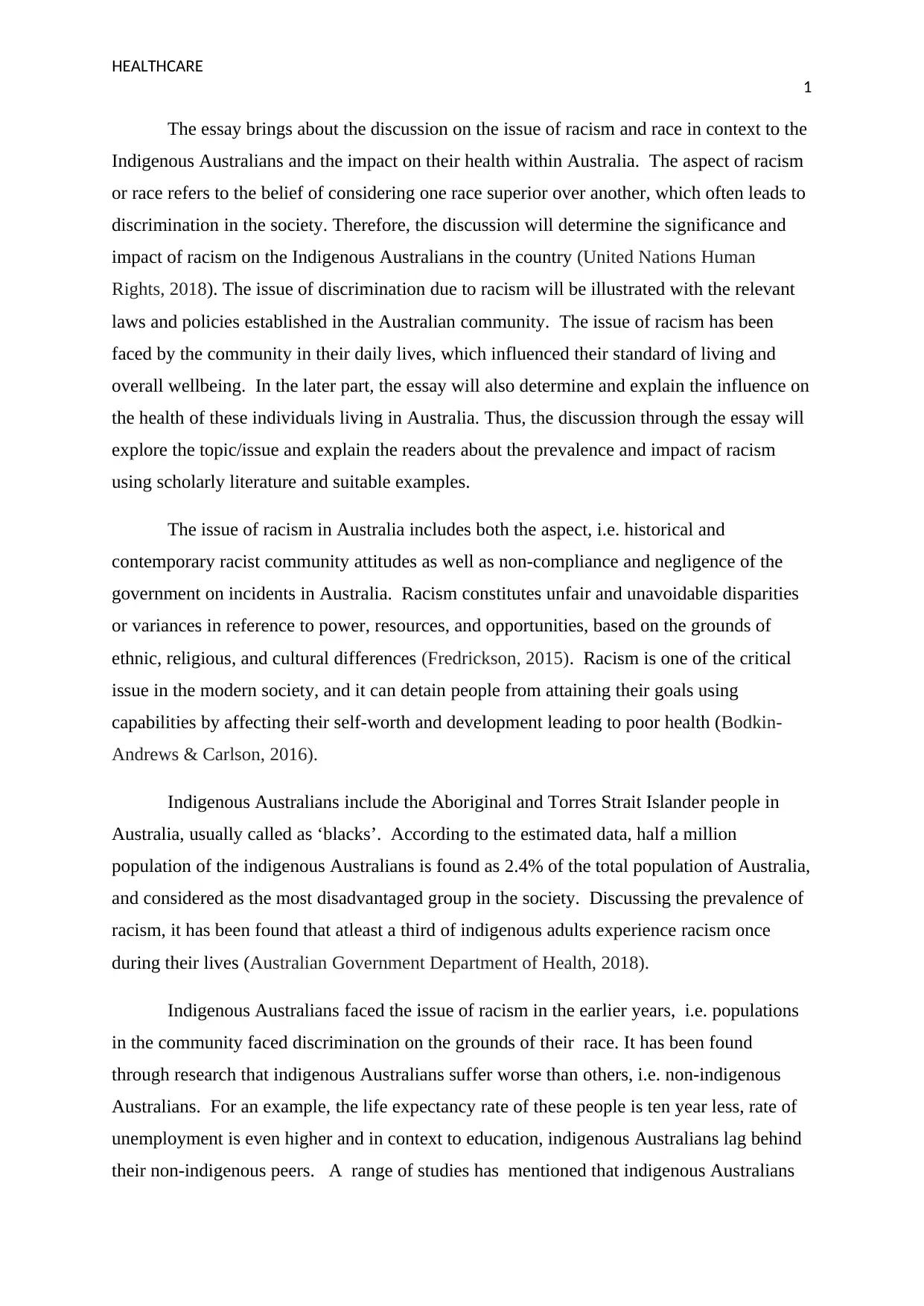
HEALTHCARE
1
The essay brings about the discussion on the issue of racism and race in context to the
Indigenous Australians and the impact on their health within Australia. The aspect of racism
or race refers to the belief of considering one race superior over another, which often leads to
discrimination in the society. Therefore, the discussion will determine the significance and
impact of racism on the Indigenous Australians in the country (United Nations Human
Rights, 2018). The issue of discrimination due to racism will be illustrated with the relevant
laws and policies established in the Australian community. The issue of racism has been
faced by the community in their daily lives, which influenced their standard of living and
overall wellbeing. In the later part, the essay will also determine and explain the influence on
the health of these individuals living in Australia. Thus, the discussion through the essay will
explore the topic/issue and explain the readers about the prevalence and impact of racism
using scholarly literature and suitable examples.
The issue of racism in Australia includes both the aspect, i.e. historical and
contemporary racist community attitudes as well as non-compliance and negligence of the
government on incidents in Australia. Racism constitutes unfair and unavoidable disparities
or variances in reference to power, resources, and opportunities, based on the grounds of
ethnic, religious, and cultural differences (Fredrickson, 2015). Racism is one of the critical
issue in the modern society, and it can detain people from attaining their goals using
capabilities by affecting their self-worth and development leading to poor health (Bodkin-
Andrews & Carlson, 2016).
Indigenous Australians include the Aboriginal and Torres Strait Islander people in
Australia, usually called as ‘blacks’. According to the estimated data, half a million
population of the indigenous Australians is found as 2.4% of the total population of Australia,
and considered as the most disadvantaged group in the society. Discussing the prevalence of
racism, it has been found that atleast a third of indigenous adults experience racism once
during their lives (Australian Government Department of Health, 2018).
Indigenous Australians faced the issue of racism in the earlier years, i.e. populations
in the community faced discrimination on the grounds of their race. It has been found
through research that indigenous Australians suffer worse than others, i.e. non-indigenous
Australians. For an example, the life expectancy rate of these people is ten year less, rate of
unemployment is even higher and in context to education, indigenous Australians lag behind
their non-indigenous peers. A range of studies has mentioned that indigenous Australians
1
The essay brings about the discussion on the issue of racism and race in context to the
Indigenous Australians and the impact on their health within Australia. The aspect of racism
or race refers to the belief of considering one race superior over another, which often leads to
discrimination in the society. Therefore, the discussion will determine the significance and
impact of racism on the Indigenous Australians in the country (United Nations Human
Rights, 2018). The issue of discrimination due to racism will be illustrated with the relevant
laws and policies established in the Australian community. The issue of racism has been
faced by the community in their daily lives, which influenced their standard of living and
overall wellbeing. In the later part, the essay will also determine and explain the influence on
the health of these individuals living in Australia. Thus, the discussion through the essay will
explore the topic/issue and explain the readers about the prevalence and impact of racism
using scholarly literature and suitable examples.
The issue of racism in Australia includes both the aspect, i.e. historical and
contemporary racist community attitudes as well as non-compliance and negligence of the
government on incidents in Australia. Racism constitutes unfair and unavoidable disparities
or variances in reference to power, resources, and opportunities, based on the grounds of
ethnic, religious, and cultural differences (Fredrickson, 2015). Racism is one of the critical
issue in the modern society, and it can detain people from attaining their goals using
capabilities by affecting their self-worth and development leading to poor health (Bodkin-
Andrews & Carlson, 2016).
Indigenous Australians include the Aboriginal and Torres Strait Islander people in
Australia, usually called as ‘blacks’. According to the estimated data, half a million
population of the indigenous Australians is found as 2.4% of the total population of Australia,
and considered as the most disadvantaged group in the society. Discussing the prevalence of
racism, it has been found that atleast a third of indigenous adults experience racism once
during their lives (Australian Government Department of Health, 2018).
Indigenous Australians faced the issue of racism in the earlier years, i.e. populations
in the community faced discrimination on the grounds of their race. It has been found
through research that indigenous Australians suffer worse than others, i.e. non-indigenous
Australians. For an example, the life expectancy rate of these people is ten year less, rate of
unemployment is even higher and in context to education, indigenous Australians lag behind
their non-indigenous peers. A range of studies has mentioned that indigenous Australians
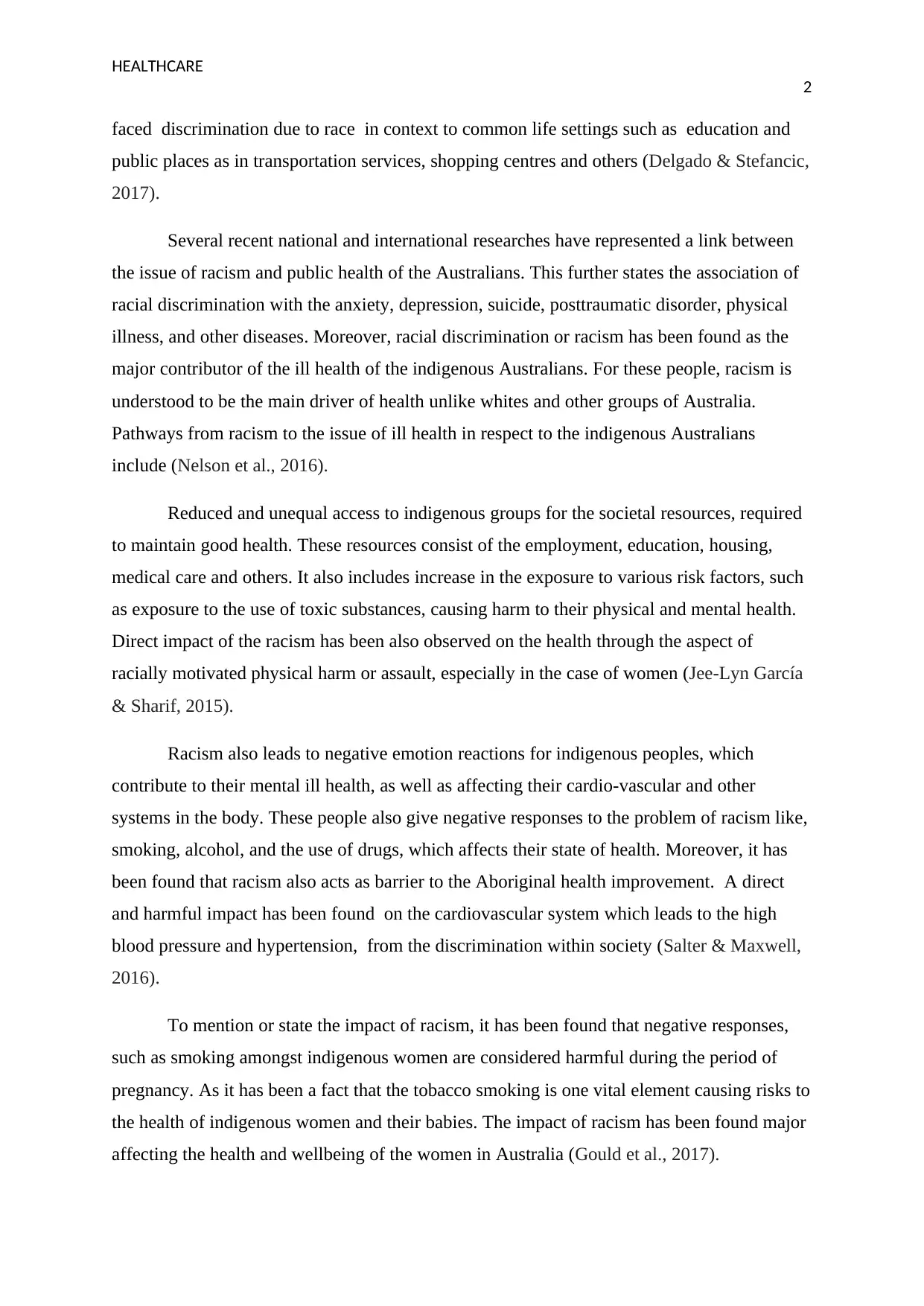
HEALTHCARE
2
faced discrimination due to race in context to common life settings such as education and
public places as in transportation services, shopping centres and others (Delgado & Stefancic,
2017).
Several recent national and international researches have represented a link between
the issue of racism and public health of the Australians. This further states the association of
racial discrimination with the anxiety, depression, suicide, posttraumatic disorder, physical
illness, and other diseases. Moreover, racial discrimination or racism has been found as the
major contributor of the ill health of the indigenous Australians. For these people, racism is
understood to be the main driver of health unlike whites and other groups of Australia.
Pathways from racism to the issue of ill health in respect to the indigenous Australians
include (Nelson et al., 2016).
Reduced and unequal access to indigenous groups for the societal resources, required
to maintain good health. These resources consist of the employment, education, housing,
medical care and others. It also includes increase in the exposure to various risk factors, such
as exposure to the use of toxic substances, causing harm to their physical and mental health.
Direct impact of the racism has been also observed on the health through the aspect of
racially motivated physical harm or assault, especially in the case of women (Jee-Lyn García
& Sharif, 2015).
Racism also leads to negative emotion reactions for indigenous peoples, which
contribute to their mental ill health, as well as affecting their cardio-vascular and other
systems in the body. These people also give negative responses to the problem of racism like,
smoking, alcohol, and the use of drugs, which affects their state of health. Moreover, it has
been found that racism also acts as barrier to the Aboriginal health improvement. A direct
and harmful impact has been found on the cardiovascular system which leads to the high
blood pressure and hypertension, from the discrimination within society (Salter & Maxwell,
2016).
To mention or state the impact of racism, it has been found that negative responses,
such as smoking amongst indigenous women are considered harmful during the period of
pregnancy. As it has been a fact that the tobacco smoking is one vital element causing risks to
the health of indigenous women and their babies. The impact of racism has been found major
affecting the health and wellbeing of the women in Australia (Gould et al., 2017).
2
faced discrimination due to race in context to common life settings such as education and
public places as in transportation services, shopping centres and others (Delgado & Stefancic,
2017).
Several recent national and international researches have represented a link between
the issue of racism and public health of the Australians. This further states the association of
racial discrimination with the anxiety, depression, suicide, posttraumatic disorder, physical
illness, and other diseases. Moreover, racial discrimination or racism has been found as the
major contributor of the ill health of the indigenous Australians. For these people, racism is
understood to be the main driver of health unlike whites and other groups of Australia.
Pathways from racism to the issue of ill health in respect to the indigenous Australians
include (Nelson et al., 2016).
Reduced and unequal access to indigenous groups for the societal resources, required
to maintain good health. These resources consist of the employment, education, housing,
medical care and others. It also includes increase in the exposure to various risk factors, such
as exposure to the use of toxic substances, causing harm to their physical and mental health.
Direct impact of the racism has been also observed on the health through the aspect of
racially motivated physical harm or assault, especially in the case of women (Jee-Lyn García
& Sharif, 2015).
Racism also leads to negative emotion reactions for indigenous peoples, which
contribute to their mental ill health, as well as affecting their cardio-vascular and other
systems in the body. These people also give negative responses to the problem of racism like,
smoking, alcohol, and the use of drugs, which affects their state of health. Moreover, it has
been found that racism also acts as barrier to the Aboriginal health improvement. A direct
and harmful impact has been found on the cardiovascular system which leads to the high
blood pressure and hypertension, from the discrimination within society (Salter & Maxwell,
2016).
To mention or state the impact of racism, it has been found that negative responses,
such as smoking amongst indigenous women are considered harmful during the period of
pregnancy. As it has been a fact that the tobacco smoking is one vital element causing risks to
the health of indigenous women and their babies. The impact of racism has been found major
affecting the health and wellbeing of the women in Australia (Gould et al., 2017).
⊘ This is a preview!⊘
Do you want full access?
Subscribe today to unlock all pages.

Trusted by 1+ million students worldwide

HEALTHCARE
3
In Australia, it has been found that the indigenous people suffer more in comparison
to the non-indigenous Australians in context to the access to medical care. Specifically, the
impact of racism has been widely analysed in respect to the indigenous adults as they result
ending up consuming alcohol, and other harmful substances (Shepherd et al., 2017).
Discussing about the issues faced from the access to the healthcare facilities by Strait
Islanders people of racism has led to some Aboriginal and Strait Islanders not being
diagnosed and treated on time. Besides, this 75% of the Aboriginal and Torres Strait Islander
members and staff face discrimination from their superiors and peers at their workplace
(Paradies, 2016).
Chronic exposure to the risk factors of the racism consist enhanced levels of
depression or stress among indigenous peoples, one of major determinant of obesity and other
diseases. Analysis of the 2014-15 survey on health has stated that the indigenous Australians
were 1.3 times likely to report incidences of cardiovascular diseases, living with high levels
of psychological distress (Waterworth et al., 2016). The problem of psychological distress,
physical assaults, and other impacts on the health of Aboriginals led to the issues of
insecurity, and inequality to participate in the aspects of community life. Aboriginals or
Indigenous Australians face racism within health care, which determines the root cause of
psychological distress amongst individuals (Bastos, Harnois & Paradies, 2018).
Reduced levels of participation have been found in respect to the sports, recreation
activities, and festivals. Mental health inequality within the population of Aboriginals i.e.
Indigenous Australian peoples is linked to the aspect of inequality of income or low-levels of
income. Further, low-income levels is associated or connected with the differential
employment and education outcomes (Hollinsworth, 2016).
Moreover, the adult indigenous Australians at their younger age face the problem of
secretion of the stress hormone cortisol, which was associated to the racism experienced
during adulthood. One in every five admits that they would discriminate in some of the
situations. As one in 10 would avoid sitting adjacent or with any Indigenous Australian in a
public transport, and similarly it applies to other common settings or aspects of life. In
addition, one in 10 would not recruit or promote any indigenous Australian individual or
candidate for the job. Motivation to modify or improve behaviour needs to be undertaken in
the cases of indigenous Australians to decrease the issues of ill health and other illness. Thus,
3
In Australia, it has been found that the indigenous people suffer more in comparison
to the non-indigenous Australians in context to the access to medical care. Specifically, the
impact of racism has been widely analysed in respect to the indigenous adults as they result
ending up consuming alcohol, and other harmful substances (Shepherd et al., 2017).
Discussing about the issues faced from the access to the healthcare facilities by Strait
Islanders people of racism has led to some Aboriginal and Strait Islanders not being
diagnosed and treated on time. Besides, this 75% of the Aboriginal and Torres Strait Islander
members and staff face discrimination from their superiors and peers at their workplace
(Paradies, 2016).
Chronic exposure to the risk factors of the racism consist enhanced levels of
depression or stress among indigenous peoples, one of major determinant of obesity and other
diseases. Analysis of the 2014-15 survey on health has stated that the indigenous Australians
were 1.3 times likely to report incidences of cardiovascular diseases, living with high levels
of psychological distress (Waterworth et al., 2016). The problem of psychological distress,
physical assaults, and other impacts on the health of Aboriginals led to the issues of
insecurity, and inequality to participate in the aspects of community life. Aboriginals or
Indigenous Australians face racism within health care, which determines the root cause of
psychological distress amongst individuals (Bastos, Harnois & Paradies, 2018).
Reduced levels of participation have been found in respect to the sports, recreation
activities, and festivals. Mental health inequality within the population of Aboriginals i.e.
Indigenous Australian peoples is linked to the aspect of inequality of income or low-levels of
income. Further, low-income levels is associated or connected with the differential
employment and education outcomes (Hollinsworth, 2016).
Moreover, the adult indigenous Australians at their younger age face the problem of
secretion of the stress hormone cortisol, which was associated to the racism experienced
during adulthood. One in every five admits that they would discriminate in some of the
situations. As one in 10 would avoid sitting adjacent or with any Indigenous Australian in a
public transport, and similarly it applies to other common settings or aspects of life. In
addition, one in 10 would not recruit or promote any indigenous Australian individual or
candidate for the job. Motivation to modify or improve behaviour needs to be undertaken in
the cases of indigenous Australians to decrease the issues of ill health and other illness. Thus,
Paraphrase This Document
Need a fresh take? Get an instant paraphrase of this document with our AI Paraphraser
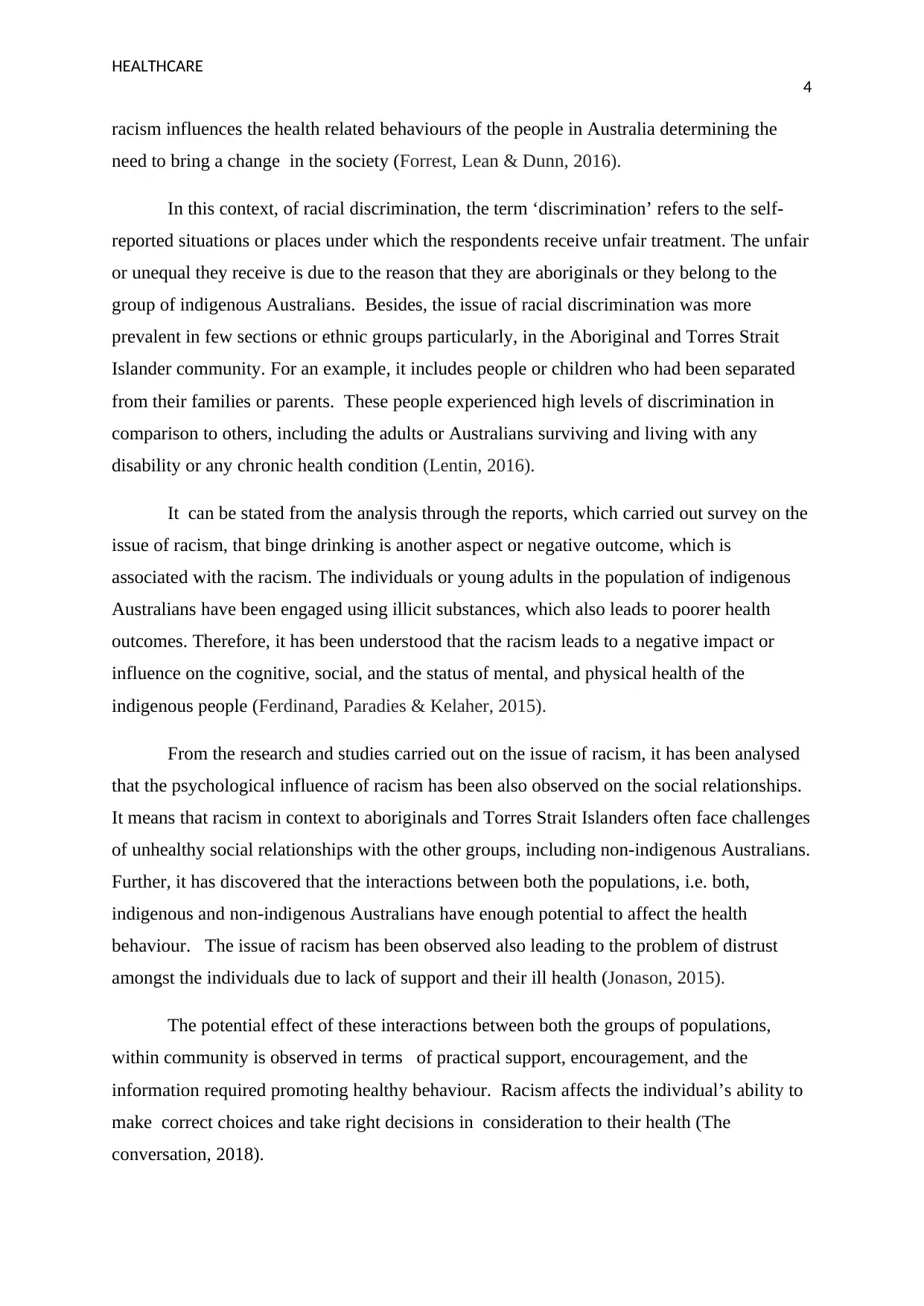
HEALTHCARE
4
racism influences the health related behaviours of the people in Australia determining the
need to bring a change in the society (Forrest, Lean & Dunn, 2016).
In this context, of racial discrimination, the term ‘discrimination’ refers to the self-
reported situations or places under which the respondents receive unfair treatment. The unfair
or unequal they receive is due to the reason that they are aboriginals or they belong to the
group of indigenous Australians. Besides, the issue of racial discrimination was more
prevalent in few sections or ethnic groups particularly, in the Aboriginal and Torres Strait
Islander community. For an example, it includes people or children who had been separated
from their families or parents. These people experienced high levels of discrimination in
comparison to others, including the adults or Australians surviving and living with any
disability or any chronic health condition (Lentin, 2016).
It can be stated from the analysis through the reports, which carried out survey on the
issue of racism, that binge drinking is another aspect or negative outcome, which is
associated with the racism. The individuals or young adults in the population of indigenous
Australians have been engaged using illicit substances, which also leads to poorer health
outcomes. Therefore, it has been understood that the racism leads to a negative impact or
influence on the cognitive, social, and the status of mental, and physical health of the
indigenous people (Ferdinand, Paradies & Kelaher, 2015).
From the research and studies carried out on the issue of racism, it has been analysed
that the psychological influence of racism has been also observed on the social relationships.
It means that racism in context to aboriginals and Torres Strait Islanders often face challenges
of unhealthy social relationships with the other groups, including non-indigenous Australians.
Further, it has discovered that the interactions between both the populations, i.e. both,
indigenous and non-indigenous Australians have enough potential to affect the health
behaviour. The issue of racism has been observed also leading to the problem of distrust
amongst the individuals due to lack of support and their ill health (Jonason, 2015).
The potential effect of these interactions between both the groups of populations,
within community is observed in terms of practical support, encouragement, and the
information required promoting healthy behaviour. Racism affects the individual’s ability to
make correct choices and take right decisions in consideration to their health (The
conversation, 2018).
4
racism influences the health related behaviours of the people in Australia determining the
need to bring a change in the society (Forrest, Lean & Dunn, 2016).
In this context, of racial discrimination, the term ‘discrimination’ refers to the self-
reported situations or places under which the respondents receive unfair treatment. The unfair
or unequal they receive is due to the reason that they are aboriginals or they belong to the
group of indigenous Australians. Besides, the issue of racial discrimination was more
prevalent in few sections or ethnic groups particularly, in the Aboriginal and Torres Strait
Islander community. For an example, it includes people or children who had been separated
from their families or parents. These people experienced high levels of discrimination in
comparison to others, including the adults or Australians surviving and living with any
disability or any chronic health condition (Lentin, 2016).
It can be stated from the analysis through the reports, which carried out survey on the
issue of racism, that binge drinking is another aspect or negative outcome, which is
associated with the racism. The individuals or young adults in the population of indigenous
Australians have been engaged using illicit substances, which also leads to poorer health
outcomes. Therefore, it has been understood that the racism leads to a negative impact or
influence on the cognitive, social, and the status of mental, and physical health of the
indigenous people (Ferdinand, Paradies & Kelaher, 2015).
From the research and studies carried out on the issue of racism, it has been analysed
that the psychological influence of racism has been also observed on the social relationships.
It means that racism in context to aboriginals and Torres Strait Islanders often face challenges
of unhealthy social relationships with the other groups, including non-indigenous Australians.
Further, it has discovered that the interactions between both the populations, i.e. both,
indigenous and non-indigenous Australians have enough potential to affect the health
behaviour. The issue of racism has been observed also leading to the problem of distrust
amongst the individuals due to lack of support and their ill health (Jonason, 2015).
The potential effect of these interactions between both the groups of populations,
within community is observed in terms of practical support, encouragement, and the
information required promoting healthy behaviour. Racism affects the individual’s ability to
make correct choices and take right decisions in consideration to their health (The
conversation, 2018).
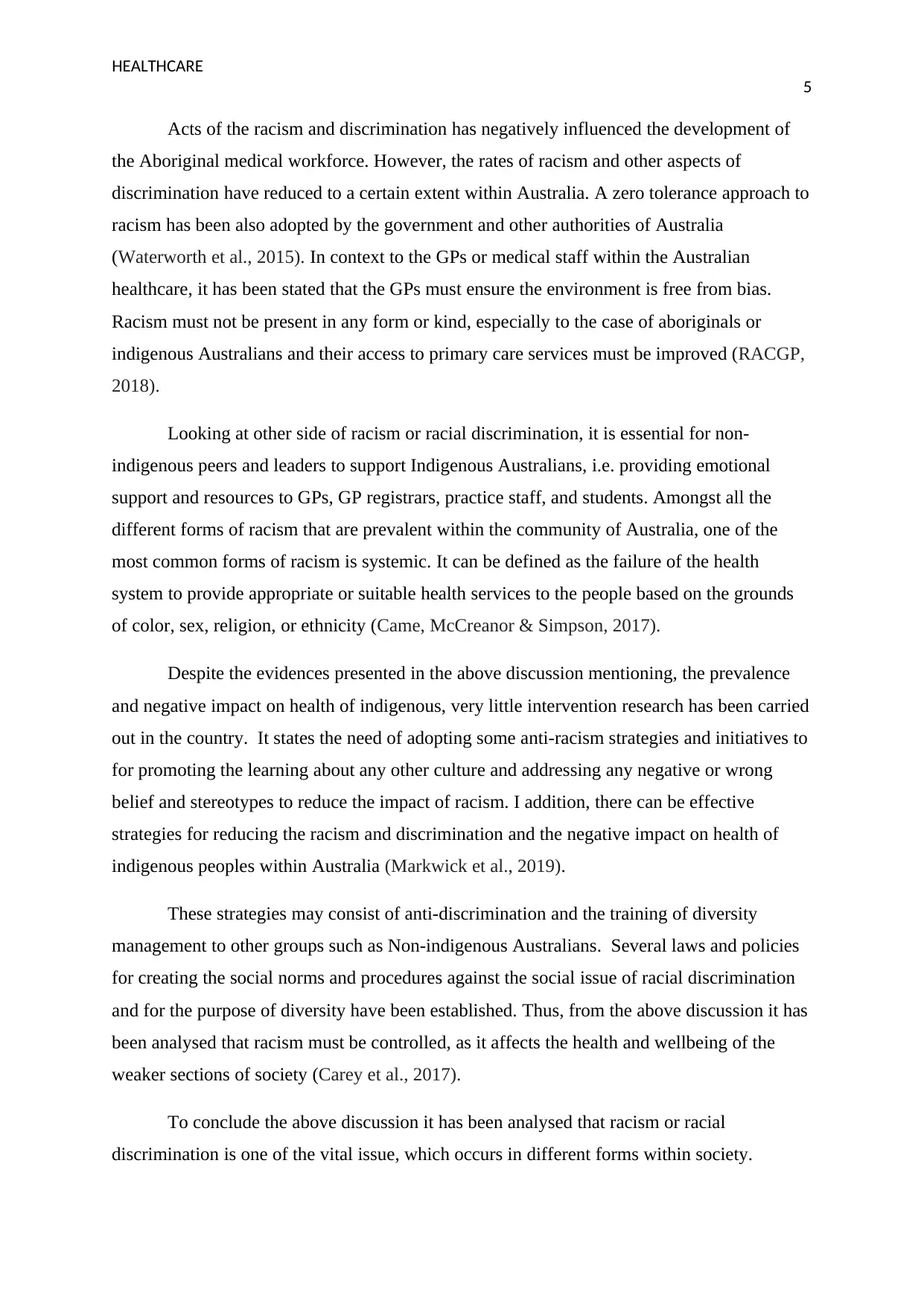
HEALTHCARE
5
Acts of the racism and discrimination has negatively influenced the development of
the Aboriginal medical workforce. However, the rates of racism and other aspects of
discrimination have reduced to a certain extent within Australia. A zero tolerance approach to
racism has been also adopted by the government and other authorities of Australia
(Waterworth et al., 2015). In context to the GPs or medical staff within the Australian
healthcare, it has been stated that the GPs must ensure the environment is free from bias.
Racism must not be present in any form or kind, especially to the case of aboriginals or
indigenous Australians and their access to primary care services must be improved (RACGP,
2018).
Looking at other side of racism or racial discrimination, it is essential for non-
indigenous peers and leaders to support Indigenous Australians, i.e. providing emotional
support and resources to GPs, GP registrars, practice staff, and students. Amongst all the
different forms of racism that are prevalent within the community of Australia, one of the
most common forms of racism is systemic. It can be defined as the failure of the health
system to provide appropriate or suitable health services to the people based on the grounds
of color, sex, religion, or ethnicity (Came, McCreanor & Simpson, 2017).
Despite the evidences presented in the above discussion mentioning, the prevalence
and negative impact on health of indigenous, very little intervention research has been carried
out in the country. It states the need of adopting some anti-racism strategies and initiatives to
for promoting the learning about any other culture and addressing any negative or wrong
belief and stereotypes to reduce the impact of racism. I addition, there can be effective
strategies for reducing the racism and discrimination and the negative impact on health of
indigenous peoples within Australia (Markwick et al., 2019).
These strategies may consist of anti-discrimination and the training of diversity
management to other groups such as Non-indigenous Australians. Several laws and policies
for creating the social norms and procedures against the social issue of racial discrimination
and for the purpose of diversity have been established. Thus, from the above discussion it has
been analysed that racism must be controlled, as it affects the health and wellbeing of the
weaker sections of society (Carey et al., 2017).
To conclude the above discussion it has been analysed that racism or racial
discrimination is one of the vital issue, which occurs in different forms within society.
5
Acts of the racism and discrimination has negatively influenced the development of
the Aboriginal medical workforce. However, the rates of racism and other aspects of
discrimination have reduced to a certain extent within Australia. A zero tolerance approach to
racism has been also adopted by the government and other authorities of Australia
(Waterworth et al., 2015). In context to the GPs or medical staff within the Australian
healthcare, it has been stated that the GPs must ensure the environment is free from bias.
Racism must not be present in any form or kind, especially to the case of aboriginals or
indigenous Australians and their access to primary care services must be improved (RACGP,
2018).
Looking at other side of racism or racial discrimination, it is essential for non-
indigenous peers and leaders to support Indigenous Australians, i.e. providing emotional
support and resources to GPs, GP registrars, practice staff, and students. Amongst all the
different forms of racism that are prevalent within the community of Australia, one of the
most common forms of racism is systemic. It can be defined as the failure of the health
system to provide appropriate or suitable health services to the people based on the grounds
of color, sex, religion, or ethnicity (Came, McCreanor & Simpson, 2017).
Despite the evidences presented in the above discussion mentioning, the prevalence
and negative impact on health of indigenous, very little intervention research has been carried
out in the country. It states the need of adopting some anti-racism strategies and initiatives to
for promoting the learning about any other culture and addressing any negative or wrong
belief and stereotypes to reduce the impact of racism. I addition, there can be effective
strategies for reducing the racism and discrimination and the negative impact on health of
indigenous peoples within Australia (Markwick et al., 2019).
These strategies may consist of anti-discrimination and the training of diversity
management to other groups such as Non-indigenous Australians. Several laws and policies
for creating the social norms and procedures against the social issue of racial discrimination
and for the purpose of diversity have been established. Thus, from the above discussion it has
been analysed that racism must be controlled, as it affects the health and wellbeing of the
weaker sections of society (Carey et al., 2017).
To conclude the above discussion it has been analysed that racism or racial
discrimination is one of the vital issue, which occurs in different forms within society.
⊘ This is a preview!⊘
Do you want full access?
Subscribe today to unlock all pages.

Trusted by 1+ million students worldwide
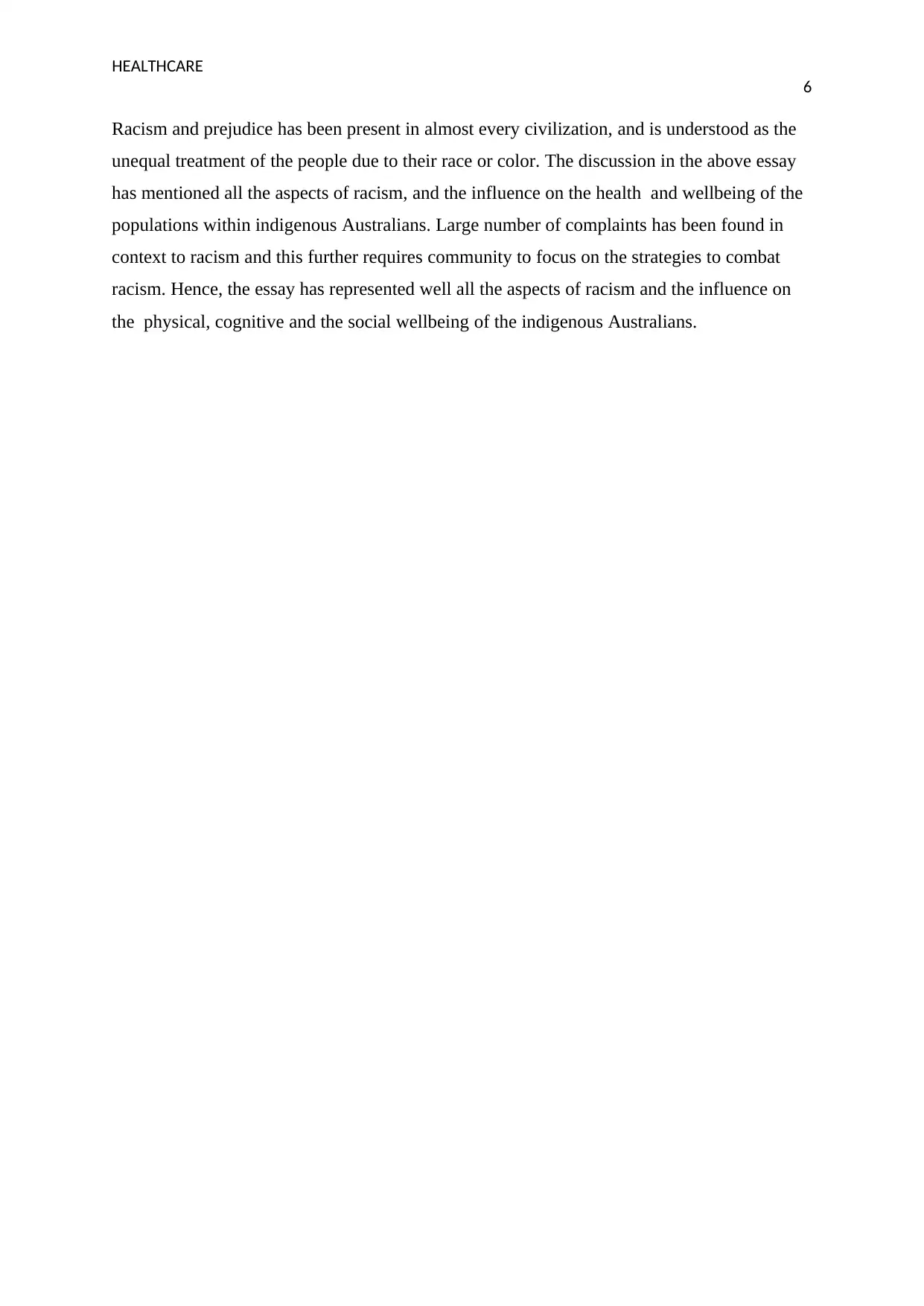
HEALTHCARE
6
Racism and prejudice has been present in almost every civilization, and is understood as the
unequal treatment of the people due to their race or color. The discussion in the above essay
has mentioned all the aspects of racism, and the influence on the health and wellbeing of the
populations within indigenous Australians. Large number of complaints has been found in
context to racism and this further requires community to focus on the strategies to combat
racism. Hence, the essay has represented well all the aspects of racism and the influence on
the physical, cognitive and the social wellbeing of the indigenous Australians.
6
Racism and prejudice has been present in almost every civilization, and is understood as the
unequal treatment of the people due to their race or color. The discussion in the above essay
has mentioned all the aspects of racism, and the influence on the health and wellbeing of the
populations within indigenous Australians. Large number of complaints has been found in
context to racism and this further requires community to focus on the strategies to combat
racism. Hence, the essay has represented well all the aspects of racism and the influence on
the physical, cognitive and the social wellbeing of the indigenous Australians.
Paraphrase This Document
Need a fresh take? Get an instant paraphrase of this document with our AI Paraphraser
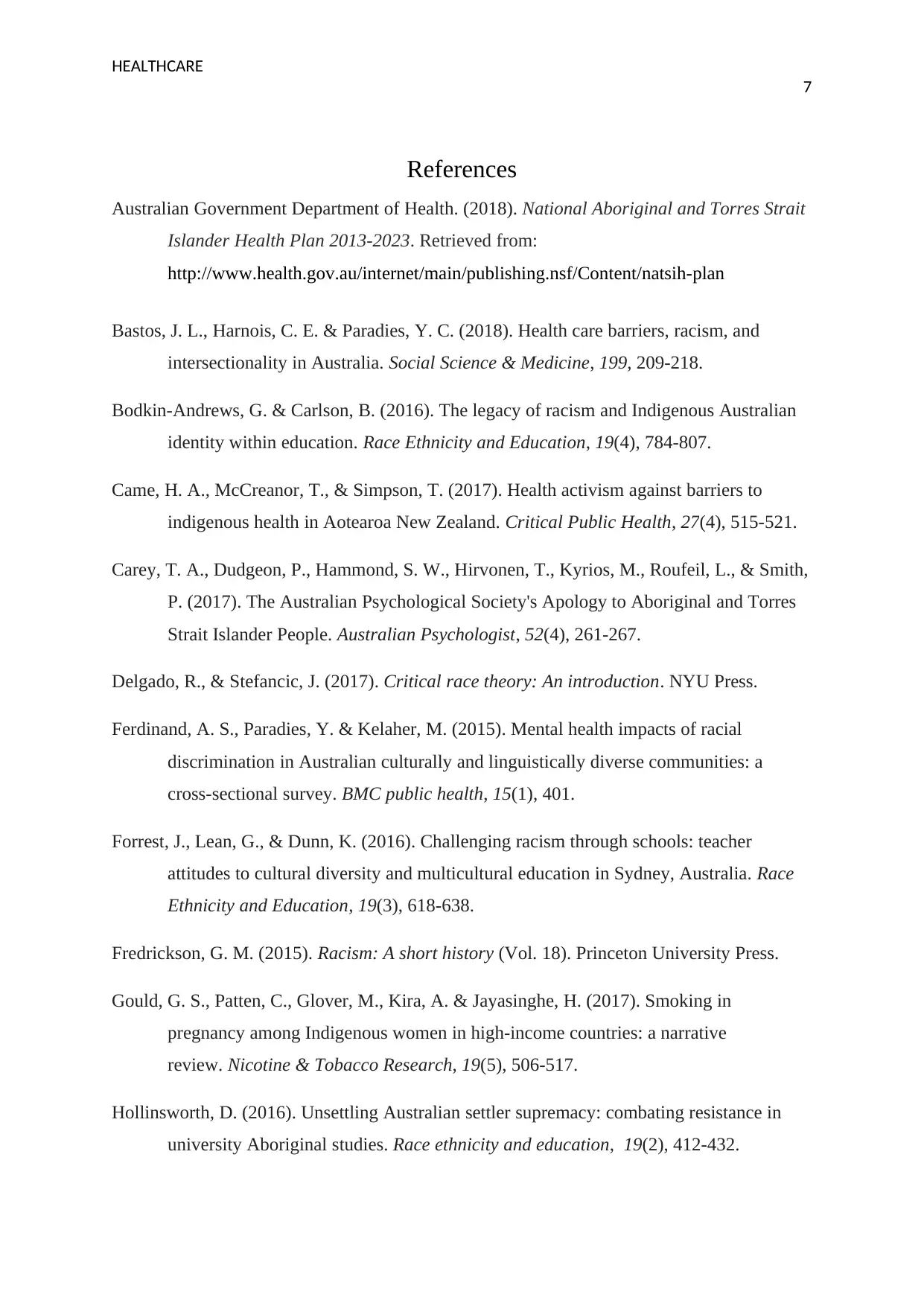
HEALTHCARE
7
References
Australian Government Department of Health. (2018). National Aboriginal and Torres Strait
Islander Health Plan 2013-2023. Retrieved from:
http://www.health.gov.au/internet/main/publishing.nsf/Content/natsih-plan
Bastos, J. L., Harnois, C. E. & Paradies, Y. C. (2018). Health care barriers, racism, and
intersectionality in Australia. Social Science & Medicine, 199, 209-218.
Bodkin-Andrews, G. & Carlson, B. (2016). The legacy of racism and Indigenous Australian
identity within education. Race Ethnicity and Education, 19(4), 784-807.
Came, H. A., McCreanor, T., & Simpson, T. (2017). Health activism against barriers to
indigenous health in Aotearoa New Zealand. Critical Public Health, 27(4), 515-521.
Carey, T. A., Dudgeon, P., Hammond, S. W., Hirvonen, T., Kyrios, M., Roufeil, L., & Smith,
P. (2017). The Australian Psychological Society's Apology to Aboriginal and Torres
Strait Islander People. Australian Psychologist, 52(4), 261-267.
Delgado, R., & Stefancic, J. (2017). Critical race theory: An introduction. NYU Press.
Ferdinand, A. S., Paradies, Y. & Kelaher, M. (2015). Mental health impacts of racial
discrimination in Australian culturally and linguistically diverse communities: a
cross-sectional survey. BMC public health, 15(1), 401.
Forrest, J., Lean, G., & Dunn, K. (2016). Challenging racism through schools: teacher
attitudes to cultural diversity and multicultural education in Sydney, Australia. Race
Ethnicity and Education, 19(3), 618-638.
Fredrickson, G. M. (2015). Racism: A short history (Vol. 18). Princeton University Press.
Gould, G. S., Patten, C., Glover, M., Kira, A. & Jayasinghe, H. (2017). Smoking in
pregnancy among Indigenous women in high-income countries: a narrative
review. Nicotine & Tobacco Research, 19(5), 506-517.
Hollinsworth, D. (2016). Unsettling Australian settler supremacy: combating resistance in
university Aboriginal studies. Race ethnicity and education, 19(2), 412-432.
7
References
Australian Government Department of Health. (2018). National Aboriginal and Torres Strait
Islander Health Plan 2013-2023. Retrieved from:
http://www.health.gov.au/internet/main/publishing.nsf/Content/natsih-plan
Bastos, J. L., Harnois, C. E. & Paradies, Y. C. (2018). Health care barriers, racism, and
intersectionality in Australia. Social Science & Medicine, 199, 209-218.
Bodkin-Andrews, G. & Carlson, B. (2016). The legacy of racism and Indigenous Australian
identity within education. Race Ethnicity and Education, 19(4), 784-807.
Came, H. A., McCreanor, T., & Simpson, T. (2017). Health activism against barriers to
indigenous health in Aotearoa New Zealand. Critical Public Health, 27(4), 515-521.
Carey, T. A., Dudgeon, P., Hammond, S. W., Hirvonen, T., Kyrios, M., Roufeil, L., & Smith,
P. (2017). The Australian Psychological Society's Apology to Aboriginal and Torres
Strait Islander People. Australian Psychologist, 52(4), 261-267.
Delgado, R., & Stefancic, J. (2017). Critical race theory: An introduction. NYU Press.
Ferdinand, A. S., Paradies, Y. & Kelaher, M. (2015). Mental health impacts of racial
discrimination in Australian culturally and linguistically diverse communities: a
cross-sectional survey. BMC public health, 15(1), 401.
Forrest, J., Lean, G., & Dunn, K. (2016). Challenging racism through schools: teacher
attitudes to cultural diversity and multicultural education in Sydney, Australia. Race
Ethnicity and Education, 19(3), 618-638.
Fredrickson, G. M. (2015). Racism: A short history (Vol. 18). Princeton University Press.
Gould, G. S., Patten, C., Glover, M., Kira, A. & Jayasinghe, H. (2017). Smoking in
pregnancy among Indigenous women in high-income countries: a narrative
review. Nicotine & Tobacco Research, 19(5), 506-517.
Hollinsworth, D. (2016). Unsettling Australian settler supremacy: combating resistance in
university Aboriginal studies. Race ethnicity and education, 19(2), 412-432.

HEALTHCARE
8
Jee-Lyn García, J. & Sharif, M. Z. (2015). Black lives matter: a commentary on racism and
public health. American journal of public health, 105(8), 27-30.
Jonason, P. K. (2015). How “dark” personality traits and perceptions come together to predict
racism in Australia. Personality and Individual Differences, 72, 47-51.
Lentin, A. (2016). Racism in public or public racism: doing anti-racism in ‘post-racial
times. Ethnic and Racial Studies, 39(1), 33-48.
Markwick, A., Ansari, Z., Clinch, D. & McNeil, J. (2019). Experiences of racism among
Aboriginal and Torres Strait Islander adults living in the Australian state of Victoria: a
cross-sectional population-based study. BMC public health, 19(1), 309.
Nelson, J., MacDonald, H., Dufty-Jones, R., Dunn, K. & Paradies, Y. (2016). Ethnic
discrimination in private rental housing markets in Australia. In Housing in 21st-
Century Australia (pp. 53-70). United Kingdom: Routledge.
Paradies, Y. (2016). Colonisation, racism and indigenous health. Journal of Population
Research, 33(1), 83-96.
RACGP. (2018). Aboriginal and Torres Strait Islander health. Retrieved from:
https://www.racgp.org.au/FSDEDEV/media/documents/RACGP/Position
%20statements/Racism-in-the-healthcare-sector.pdf
Salter, P., & Maxwell, J. (2016). The inherent vulnerability of the Australian Curriculum’s
cross-curriculum priorities. Critical Studies in Education, 57(3), 296-312.
Shepherd, C. C., Li, J., Cooper, M. N., Hopkins, K. D., & Farrant, B. M. (2017). The impact
of racial discrimination on the health of Australian Indigenous children aged 5–10
years: analysis of national longitudinal data. International journal for equity in
health, 16(1), 116.
The conversation. (2018). Twelve charts on race and racism in Australia. Retrieved from:
https://theconversation.com/twelve-charts-on-race-and-racism-in-australia-105961
United Nations Human Rights. (2018). Committee on the Elimination of Racial
Discrimination examines Australia’s report. Retrieved from:
https://www.ohchr.org/en/NewsEvents/Pages/DisplayNews.aspx?
NewsID=22460&LangID=E
8
Jee-Lyn García, J. & Sharif, M. Z. (2015). Black lives matter: a commentary on racism and
public health. American journal of public health, 105(8), 27-30.
Jonason, P. K. (2015). How “dark” personality traits and perceptions come together to predict
racism in Australia. Personality and Individual Differences, 72, 47-51.
Lentin, A. (2016). Racism in public or public racism: doing anti-racism in ‘post-racial
times. Ethnic and Racial Studies, 39(1), 33-48.
Markwick, A., Ansari, Z., Clinch, D. & McNeil, J. (2019). Experiences of racism among
Aboriginal and Torres Strait Islander adults living in the Australian state of Victoria: a
cross-sectional population-based study. BMC public health, 19(1), 309.
Nelson, J., MacDonald, H., Dufty-Jones, R., Dunn, K. & Paradies, Y. (2016). Ethnic
discrimination in private rental housing markets in Australia. In Housing in 21st-
Century Australia (pp. 53-70). United Kingdom: Routledge.
Paradies, Y. (2016). Colonisation, racism and indigenous health. Journal of Population
Research, 33(1), 83-96.
RACGP. (2018). Aboriginal and Torres Strait Islander health. Retrieved from:
https://www.racgp.org.au/FSDEDEV/media/documents/RACGP/Position
%20statements/Racism-in-the-healthcare-sector.pdf
Salter, P., & Maxwell, J. (2016). The inherent vulnerability of the Australian Curriculum’s
cross-curriculum priorities. Critical Studies in Education, 57(3), 296-312.
Shepherd, C. C., Li, J., Cooper, M. N., Hopkins, K. D., & Farrant, B. M. (2017). The impact
of racial discrimination on the health of Australian Indigenous children aged 5–10
years: analysis of national longitudinal data. International journal for equity in
health, 16(1), 116.
The conversation. (2018). Twelve charts on race and racism in Australia. Retrieved from:
https://theconversation.com/twelve-charts-on-race-and-racism-in-australia-105961
United Nations Human Rights. (2018). Committee on the Elimination of Racial
Discrimination examines Australia’s report. Retrieved from:
https://www.ohchr.org/en/NewsEvents/Pages/DisplayNews.aspx?
NewsID=22460&LangID=E
⊘ This is a preview!⊘
Do you want full access?
Subscribe today to unlock all pages.

Trusted by 1+ million students worldwide

HEALTHCARE
9
Waterworth, P., Dimmock, J., Pescud, M., Braham, R. & Rosenberg, M. (2016). Factors
affecting indigenous west Australians’ health behaviour: Indigenous
perspectives. Qualitative health research, 26(1), 55-68.
Waterworth, P., Pescud, M., Braham, R., Dimmock, J. & Rosenberg, M. (2015). Factors
influencing the health behaviour of indigenous Australians: Perspectives from support
people. PloS one, 10(11), 142323.
9
Waterworth, P., Dimmock, J., Pescud, M., Braham, R. & Rosenberg, M. (2016). Factors
affecting indigenous west Australians’ health behaviour: Indigenous
perspectives. Qualitative health research, 26(1), 55-68.
Waterworth, P., Pescud, M., Braham, R., Dimmock, J. & Rosenberg, M. (2015). Factors
influencing the health behaviour of indigenous Australians: Perspectives from support
people. PloS one, 10(11), 142323.
1 out of 10
Related Documents
Your All-in-One AI-Powered Toolkit for Academic Success.
+13062052269
info@desklib.com
Available 24*7 on WhatsApp / Email
![[object Object]](/_next/static/media/star-bottom.7253800d.svg)
Unlock your academic potential
Copyright © 2020–2025 A2Z Services. All Rights Reserved. Developed and managed by ZUCOL.





